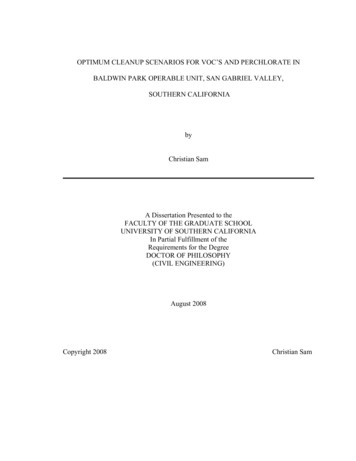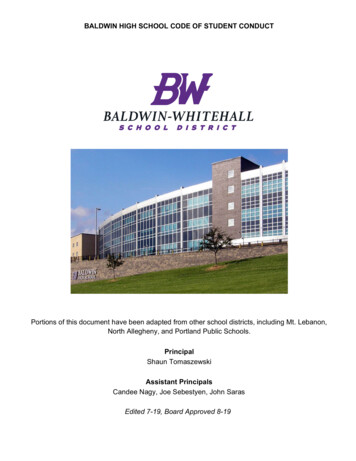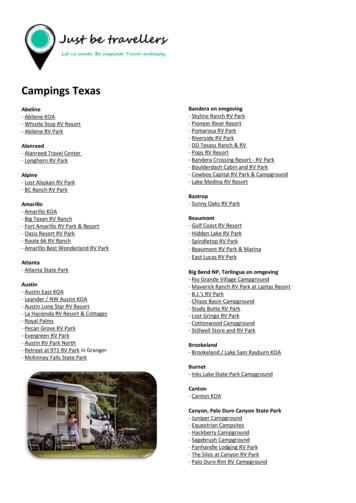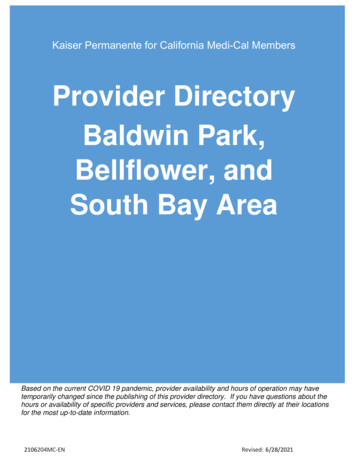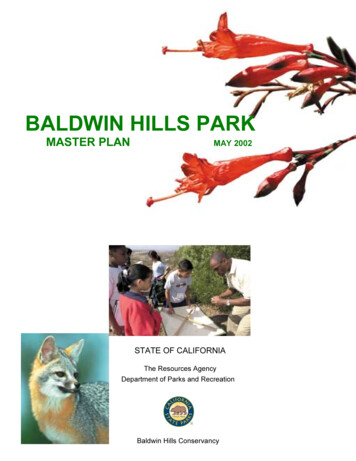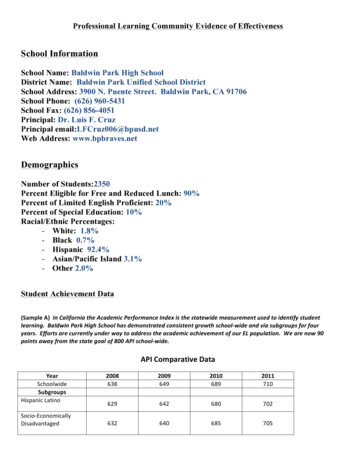
Transcription
Professional Learning Community Evidence of EffectivenessSchool InformationSchool Name: Baldwin Park High SchoolDistrict Name: Baldwin Park Unified School DistrictSchool Address: 3900 N. Puente Street. Baldwin Park, CA 91706School Phone: (626) 960-5431School Fax: (626) 856-4051Principal: Dr. Luis F. CruzPrincipal email:LFCruz006@bpusd.netWeb Address: www.bpbraves.netDemographicsNumber of Students:2350Percent Eligible for Free and Reduced Lunch: 90%Percent of Limited English Proficient: 20%Percent of Special Education: 10%Racial/Ethnic Percentages:- White: 1.8%- Black 0.7%- Hispanic 92.4%- Asian/Pacific Island 3.1%- Other 2.0%Student Achievement entgrowthschool- 00APIschool- ispanicLatinoSocio- 011710629642680702632640685705
tothecollaborativeculturewehaveestablishedviasame- inthisarea.California High School Exit Exam 10th Graders – First Time Test TakersEnglish Language l dFluent EnglishProficientSocioeconomicallyDisadvantagedNot socioeconomicallyDisadvantaged2005/0665918856267
leD)California High School Exit Exam 10th Graders – First Time Test Takers ll dFluent EnglishProficientSocioeconomicallyDisadvantagedNot 9175782009/107232438572692010/11854457958683
(SampleE )BPHSPyramidofInterventionIntervention begins when BPHS faculty, student or parent identifies a student need. Failinggrades indicate a need for intervention; however, intervention services can also be utilized bystudents who would like to perform at a higher level of success. Once a need is identified, thestudent should engage in a reflective conversation to identify the causes of the need and the bestintervention to address that need. In many cases, this conversation will be initiated by BPHSfaculty; however, students and parents can also take the initiative to begin the interventionprocess.The Pyramid of Interventions then serves as a guide to intervention services and possibilitiesavailable at Baldwin Park High School.Level ThreeSST504 PlanCredit RecoveryInitiate InterventionProcess for 1 or more F’s(Action Research)Greater Frequency of ProgressMonitoringMandated vs. Invited InterventionsLevel TwoCAHSEE BootcampReading IntensiveGuided Study CourseCyber High School/ Titan TechPeer Pals Mentors for identified studentsParent/Teacher/Counselor referred SST’sInitiate Intervention Process for 1 or more F’sAcademic Interventions by Teacher Leaders, Counselors &AdministratorsLevel OneELD CoursesParent Teacher ConferencesSmaller Learning CommunitiesConnect-ed Messages to ParentsCalifornia Standards Based InstructionSame Subject Teacher Meetings (Data Analysis)Identify F students and discuss why students are experiencing difficultyDifferentiated Instruction & Interventions to meet needs of studentsProgress monitoring of learning through multiple formative assessmentsTeacher monitors all students’ grade progress and provides feedback every 3 weeks.Teacher identifies students who are not passing or at risk of failure based on monitored progress.Online gradebook available for parents/students to keep accurate accounts of classroom progressAfterschool Tutoring Program: General Tutoring Center, Math Tutoring Center & CAHSEE Center
(SampleF)
(SampleG)
CAHSEE%PassRateComparisonVia the work of our California High School Exit Exam Task Force, a teacher lead group whofocus on collaborating and practicing collective inquiry so as to generate action research aimedat increasing student learning for all students, our passage rate on the state mandated CAHSEE(a graduation requirement in California) has shown notable gains. Please note that schoolsnoted in this comparison serve very similar students populations as those served at BaldwinPark High School.EnglishLearnersCAHSEE%PassRateComparison
2010- ‐2011GraduationRateComparisonPlease note that the comparison data noted to demonstrate our graduation rate is with otherschools who share similar student demographics. California’s percentage includes all highschools. BPHS’s 91% graduation rate is significantly higher when compared to other lowincome mostly Latino bove
ase note that the state accountability system in California uses the Academic PerformanceIndex to measure student achievement. The goal in California is that all schools will meet the800 API target. BPHS is well on its way as it has experienced more than a 100 point gain in thelast six years. Note that the state average includes all California schools and the others schoolsin this comparison share similar student demographics.
Please elaborate strategies you have found to be effective in the following areas:1. Monitoring student learning on a timely basis.At Baldwin Park High School teacher collaborative sessions aimed at monitoring student learningperiodically take place in a variety of formats. On Thursday’s for example, same subject teacher meetingsallow teachers who teach the same subject an uninterrupted 2 hour block focused on a host of topics aimedat optimizing student learning. Teachers and administrators spend time identifying essential academicstandards all agree must be learned by students, hence making necessary adjustments on their districtcurriculum guides if necessary. Teachers also collectively create and later analyze common formativeassessments and SMART goals which help gauge student learning. Decisions on how to best address nonlearning of students is discussed by teachers as well as best practices that have helped produce evidence ofoptimal student learning. Recently, teachers have started observing their colleagues teach based on the datashared in same-subject meetings in the hope of enhancing their own teaching. In short, teachers focus theirconversation on the three questions that guide collaborative meetings within a professional learningcommunity structure: What do we want students to know? How do we know students have learned what weas educators deem is important for them to know? What do we do when evidence of non-learning ispresent? How do we enrich the learning students are demonstrating?While substitute teachers are assigned to classrooms so as to relieve teachers for same-subject meetings, acarefully coordinated schedule allows teachers the 2 hours of uninterrupted time to collaborate so thatfuture meeting do not repeatedly affect the same students via the teachers absence from class. Forexample, on a particular Thursday the English department may be scheduled for same subject meetingsallowing 9th grade English teachers to meet from 8:00 a.m.-10:00 a.m., 10th grade teachers to meet from10:00 a.m. to 12:00 p.m. and 11th grade teachers to meet from 1:00 p.m. to 3:00 p.m. The followingThursday the Science department is assigned same subject meetings with Biology teachers meeting first,followed by Chemistry teachers and lastly Physics teachers. Each week a new department occupies thesame subject meetings until the rotation returns to the English department. On this second session of samesubject meetings for the English department, those teachers who had previously met from 8:00 a.m. to10:00 a.m. meet at a different time so that the same students who were without their teacher the first samesubject Thursday are not affected a second time. In one-school year the number of times students arewithout their teacher is minimal thus addressing the concern that teachers are frequently “out of theclassroom”.Via the implementation of common formative assessments, evidence of non-learning is identified thusinitiating a host of actions aimed at further supporting students prior to the implementation of summativeassessments. In addition to communicating academic concerns with students and parents, same-subjectteachers invite and at times mandate that students attend intervention aimed at promoting learning.Currently, the school is experimenting with a process that calls matching students in need of additionalopportunities to learn with teachers which data indicates have been the most successful at generatinglearning in a particular subject area.While Baldwin Park High School has created a school-wide focus on learning and intervention, anadditional focus has been placed on preventing student failure as early as possible. Two years ago forexample, a mandatory Guided Studies class was created for the purpose of ensuring that the mostacademically at risk incoming 9th grade students received the necessary intervention during the school dayto accomplish the goal of completing their first year of high school credit current. Still in its infancy, theguided study class generated its first accomplishment last year when 18% of the 9th grade students endedtheir first year of high school with the necessary 60 credits. Other guided study students also demonstratedsuccess by completing their first year of high school only one or two classes short of the optimal 60 credits.
2. Creating systems of intervention to provide students with additional time and support for learning.While same subject meetings act to monitor student learning within core academic areas and some electiveacademic areas as well, five years ago Baldwin Park High School invested in the creation of a newcertificated position that would allow a closer monitoring of school-wide student learning. Upon learningthat a vacancy in our certificated librarian position was available, a collective decision was made to replacethe responsibilities of the librarian with a classified position thus allowing the remaining full timeequivalent allotment to be used for the creation of a new position we labeled the Intervention Coordinator.The Intervention Coordinator job description reads as ctivitiesrelatedtotheschool- ‐wideefforttoidentifyunder- See picture of Intervention Coordinator on sample F)Considering the fact that several years ago our school was mandated by the school district to implement asmall learning community structure (SLC’s are a structure whereby our large comprehensive high school isbroken into 4 smaller schools called houses), a careful plan was collectively implemented to integrate ourintervention efforts within the SLC structure (please see sample F). As noted in sample f, the interventioncoordinator acts to “keep a pulse” on our intervention efforts by making sure real time data is gathered andprovided to a whole host of leaders within each house who actively work to implement action plans aimedat helping students who data suggest are not learning. Sample G provides in more detail the actions thattake place within each house after the first grading period identifies students failing classes. Consideringthat the first two grading periods post unofficial grades, the goal is that immediate and effectiveinterventions will allow the student to demonstrate learning by semesters end.Baldwin Park High Schools Pyramid of Intervention noted in sample E also acts as an additional indicatorof systems that have been created to ensure students who needed additional academic support are grantedan opportunity in levels two and three for the intervention necessary to optimize learning.By providing leaders within each house in our smaller learning community structure common prep periodsthat allow for them to meet during the day, Baldwin Park High School educators continue to exploreresearch and effective practices that will allow us to strengthen our intervention efforts.3. Building teacher capacity to work as members of high performing collaborative teams that focus effortson improved learning for all students.While our same-subject and small learning community structure provide ample opportunities for teachers towork collaboratively to improve learning for all students, the creation of what we call Task Forces hasallowed a collective group of educators at our site to focus their efforts on “confronting brutal facts” thatdetail strong evidence on non-learning. Emulating the role that SWAT teams play within policeorganizations (officers who through the use of special weapons and tactics confront very challenging
crimes) teachers on task forces at Baldwin Park High School work interdependently to achieve commonSMART goals and ensure that decisions made collectively are carried out independently.The English Learner Task Force was created in 2006 to address the fact that a vast majority of EnglishLearners at our high school were not learning academic English. Upon analyzing data, researching bestpractices (which included visiting other high schools that were experiencing notable success with theirEnglish learners), establishing SMART goals, and implementing a collective action plan, over time learningamong English learners dramatically increased. In 2006 for example, only 8.3% of English Learners wereat or above proficiency on the English Language Arts portion of the California State Standards Testcompared to 28.3% by 2009. On the California English Language Development Test (a test that the state ofCalifornia requires all English Learners to take once a year) only 20% of students in 2006 scored in theearly advance or advanced category compared to 40% in 2009. Most amazing was the fact that while in2006 none of our English learners had demonstrated sufficient mastery in English to be reclassified FluentEnglish Proficient; by 2009 24.9% were reclassified. Presently, the English Learner population at BaldwinPark High School has been significantly minimized; a sign that more students are learning academic Englishat a faster rate. The English Learner Task Force continues to exist at our school and is focused onuncovering other “brutal facts” that must no longer be ignored and instead tactfully and collectivelyconfronted if more English Learner students are expected to learn.The success of the English Learner Task Force launched a very positive movement on campus as moreteacher leaders sought opportunities to “practice leadership”. Today, there are five task forces comprised ofteacher leaders focused on confronting evidence of non-learning in particular domains. The five task forcesat Baldwin Park High are as follows:1. English Learner Task Force: Teacher leaders working together to address the academic needs ofEnglish Learners.2. CAHSEE Task Force: Teacher leaders working together to increase student proficiency on theCalifornia High School Exit Exam.3. Attendance Task Force: Teacher leaders working together to create systems and processes that holdstudents accountable to being present at school each day and on time.4. Writing Across the Curriculum Task Force: Teacher leaders working together to create systems andprocesses that act to improve student writing across the curriculum.5. Dual Language Task Force: Teacher leaders working together to ensure that students in the DualLanguage Program learn both academic English and Spanish simultaneously.Our initial experience with the English Learner Task Force formulated critical steps that other task forcestoday emulate as a means of ensuring productivity aimed at optimizing student learning. The steps taskforces at Baldwin Park High School initiate are as follows:Step 1:Step 2:Step 3:Step 4:Step 5:Step 6:Build a coalition that confronts the brutal facts.Do the research as to how other schools have successfully confronted and solved this problem.Create an action plan that is clearly defined and detailed.Establish SMART goals.Implement action plans.Meet periodically to assess and re-align goals if necessary.Baldwin Park High School is very proud of the focus on learning that teacher leadership via thecollaboration found in Task Forces has provided and will continue to support this effort.
List awards and recognitions your school has achieved:1. In 2007 Baldwin Park High School received a 250,000 grant from the California Academic PartnershipProgram (CAPP) for demonstrating what the organization defined as the courageous leadershipnecessary to close the achievement gap. Baldwin Park High School was only 1 of 12 schools inCalifornia who received this grant out of a pool of over 70 schools that applied.2. In 2009 Baldwin Park High School received the Golden Bell Award from the California School BoardsAssociation for demonstrating the most success in closing the achievement gap for English Learners.Over 200 schools applied for this distinction.3. In 2009 Baldwin Park High School received the Golden Bell Award from the California School BoardAssociation for demonstrating innovation in establishing “Cyber High” an accredited on-line programthat allows students to make-up credits in time for graduation.4. In December of 2009 the local media acknowledged that Baldwin Park High School was on the verge ofbreaking the all-time graduation record. For the last three years, Baldwin Park High School has set newrecords for graduating the most students in its history. Currently, the California Department ofEducation notes a 91% graduation rate for Baldwin Park High School, the highest in the school’shistory.5. In 2011 Baldwin Park High School became the high school with the highest API score among highschools in the district. While the district is only comprised of three high schools, for years Baldwin ParkHigh School had been considered the “less than high school”, a distinction that no longer holds true!
School Information School Name: Baldwin Park High School District Name: Baldwin Park Unified School District School Address: 3900 N. Puente Street. Baldwin Park, CA 91706 School Phone: (626) 960-5431 School Fax: (626) 856-4051 Principal: Dr. Luis F. Cruz Principal email:LFCruz006@bpusd.net Web Address: www.bpbraves.net Demographics
